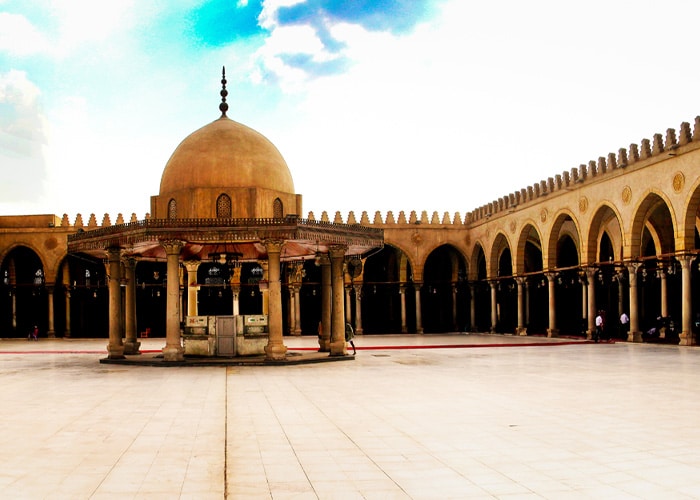Amr Ibn Al-As
Mosque of Amr Ibn Al-As: Because of the variety of civilizations in Egypt, Egypt is the best destination for most tourists. The history of Egypt is filled with many constructions that attract people from all over the world. One of the periods in which Egypt flourished was in the early Islamic dynasties.
The Islamic civilization in Cairo was very big especially in Old Cairo (Fustat). The Muslim rulers imported building mosques that is why the city of Cairo is known as “the city of a thousand minarets“.
The architecture and Islamic art are of tremendous richness and you can see it in the old streets in Old Cairo and the mosques. The most famous mosque is the Amr Ibn Alas Mosque because it is the first mosque in Egypt and Africa.

Other Names of the Mosque
The Mosque is known by other names like “the Opening”, “the Ancient Mosque” and “the Crown of the Mosques” because it is the first mosque in Egypt and all Africa.
The History of the Mosque of Amr Ibn Alas
When Amr Ibn Alas arrived in Egypt by order of the Caliph Umar, Amr Ibn Alas was camping with his army in a tent prepared to attack Alexandria. When he returned victoriously, he chose the site of the tent to build a mosque for prayers and as a center of government and preaching to Islam.
Around this site, a new city “Fustat” (the Islamic capital in Egypt) was built. The original mosque was built with wood and palm leaves and was not large. But in later dynasties, the rulers extended it until the Vizier Shawar destroyed the mosque and the city of Fustat by fire so as not to be captured by the Crusaders. In 1179 it was rebuilt by Saladin. Although the last restoration was in the 20th century, the entire mosque was built of Islamic architecture.

The Construction of the Mosque of Amr Ibn Alas
- The first form in 642; it was rectangular 29 m long and 17 m wide. It was built from palm tree trunks and mudstones. The roof was made of wood and palm leaves. The floor was of the grave.
- In 673 Governor Maslama Al-Ansari extended the mosque and added 4 minarets on the corners; one on each corner of the mosque for the call of prayer to be heard.
- In 698 Abd Al-Azis Ibn Marwan extended the mosque and doubled its size.
- In 711 a concave prayer niche was added and replaced the flat one.
- In 827 seven parallel passages were added to the wall of the Qibla (the direction that Muslims should face during prayer). In the same year, Abd Al-lah Ibn Taher extended the mosque and built the current south wall.
- In the 9th century in the Abbasid dynasty, Caliph Al-Mamun added part of it on the southwest side and it was rectangular 120 m and 112 m.
- In 1175 after the destruction by fire and the expulsion of the Crusaders, Saladin ordered the reconstruction of the mosque.
- In 1303 the mosque was restored after being destroyed by the earthquake.
- In the 18th century Mourad Bey destroyed the mosque and then in 1796, he rebuilt it. During this reconstruction, the orientation was changed and the aisles of pillars were six, not seven.
- In the 20th century, Abbas Helmi II restored the mosque. In the ’80s the entrance was rebuilt.
- About the Mosque of Amr Ibn Alas
According to tradition, the site of the mosque was chosen by a pigeon that laid an egg in the tent of Amr Ibn Alas. When he returned victoriously and found the sacred dove, he decided to build his mosque and the capital on this site. The oldest part of the Mosque is some beams along the southern wall. At one corner of the Mosque is a tomb of the son of Amr Ibn Alas.
Excursions in the Mosque of Amr Ibn Alas
The prayer continues in the Mosque of Amr Ibn Alas at the moment, it is one of the attractive destinations in Cairo that can visit it with other magical places with our travel packages to Egypt. You can also complete your trip and explore the pharaonic attractions in Luxor and Aswan with a cruise on the Nile.









